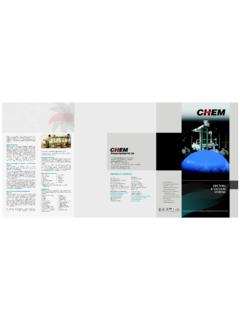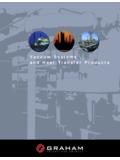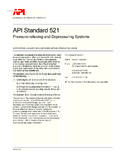Transcription of FLOW CONSIDERATIONS IN INDUSTRIAL SILENCER DESIGN
1 FLOW CONSIDERATIONS IN INDUSTRIAL SILENCER DESIGN George Feng, Kinetics Noise Control, Inc., 3570 Nashua Drive, Mississauga, Ontario Vadim Akishin, Kinetics Noise Control, Inc., 3570 Nashua Drive, Mississauga, Ontario Bruce Huynh, TransCanada PipeLines Ltd, 450-1 Street SW, Calgary, Alberta ABSTRACT This paper addresses the following aerodynamic aspects for designing INDUSTRIAL acoustic silencers . Flow analysis Flow field in a SILENCER is analyzed for velocity and pressure distribution along the flow system. The comparison of pressure drop from different methods and characteristics of these methods discussed. Consideration of SILENCER s impacts to the flow system A SILENCER is designed to attenuate noise but is naturally a part of the flow system and it can impose adverse effects on other components in the system such as fans, gas turbines, valves, elbows and ducts, etc.
2 Statically, a SILENCER and other components of the flow system affect flow distribution and pressure drop on each other. Dynamically, the installation of a SILENCER can affect the stability of the flow system or stable operation of other components, especially to flow sensitive equipment such as gas turbines. Consideration for flow characteristics in the DESIGN of a SILENCER In actual applications, the flow distribution upstream of a SILENCER is far from uniform, for example, at downstream of a butterfly valve. The methods of making SILENCER inlet flow uniform and protecting acoustic absorption material are discussed. 1. INTRODUCTION With the tightening of noise regulations, INDUSTRIAL facilities are required to stay in compliance with regulation(s).
3 INDUSTRIAL silencers are typical being used to attenuate noise coming from intake and exhaust systems of INDUSTRIAL facilities. These silencers may be built in limited space. The interaction between the SILENCER and other equipment becomes important, especially for systems with high flow velocity. INDUSTRIAL silencers discussed here include those for a large flow rate, high velocity, high pressure, and/or high temperature - for example, silencers for gas turbine power generation, coal-fired power plants, petro-chemical processes, INDUSTRIAL ventilation systems, tunnel and mine ventilation systems, steam/gas vent systems, gas turbine/jet engine test cells. Traditionally, the flow performance of a SILENCER is mainly referred to as pressure drop through the SILENCER - flow interaction between the SILENCER and its upstream and downstream equipment is usually not emphasized.
4 The standard for SILENCER pressure drop testing is ASTM E-477 [1] which is mostly preferred in North America. The methods for pressure drop calculations as discussed in Ref [2] [3] are based on simplified flow elements and usually give acceptable results although every SILENCER manufacturer use their own method of estimation with correlation from their own database. In this paper, a typical SILENCER unit is analyzed and flow interactions of SILENCER (s) with their upstream and downstream equipment are discussed. 2. FLOW ANALYSIS A typical INDUSTRIAL baffle designed SILENCER is shown in Figure1. For the purpose of illustration and comparison with lab testing, a representative single passage highlighted in yellow is taken for flow analysis.
5 The whole flow system including the inlet and outlet ducts is shown in Figure2. The flow field of the system is simulated with CFD software. Figure 1 A typical INDUSTRIAL SILENCER Figure 2 The model SILENCER with inlet and outlet ducts The main dimensions of the SILENCER are as follows: Width: 24 Height: 24 SILENCER length: 60 Open area: Inlet boundary: at 60 upstream of the SILENCER , , times of the model width Outlet boundary: at 120 downstream of the SILENCER , , 5 times of the model width The flow conditions for this flow simulation are as follows: Fluid: air at 20 C Inlet velocity: m/s Walls: no slip with roughness Outlet pressure: 0 Pa (g) relative to ambient Based on simulated results, the gas velocity and static pressure profiles are shown in Figure 3 to Figure 6 along the examined section.
6 The flow separation and wake downstream of the baffle is clearly seen. The velocity distribution on the plane at mid-height of the SILENCER is shown in Figure 4, velocity peaks near the baffle entrance at 41m/s, which is times of inlet velocity and times of average velocity through the passage; the velocity is not fully uniform at the outlet boundary. The static pressure distribution on the same mid-height plane is shown in Figure 5. The static pressure becomes uniform on cross sections perpendicular to the flow direction in a short distance from the exit of the baffle although changing along the flow direction. The section average static and total/stagnation pressure variations from the inlet to outlet are shown in Figure 6.
7 The total (stagnation) pressure decreases gradually from the inlet to outlet with larger gradients near baffle entrance and the mixing region downstream of the baffle. The static pressure decreases greatly near the baffle entrance, which corresponds to the high velocity zone; and it recovers gradually from baffle exit to the outlet boundary. The pressure difference between the inlet and outlet boundaries is defined as pressure drop, total pressure drop is 181Pa; static pressure drop is 203Pa. The difference between these two pressure drops shows that the flow at outlet is still not uniform and static pressure can further be recovered with longer distance. Figure 3 Stream lines Figure 4 Velocity profile on the mid-height plane Figure 5 Static pressure profile Figure 6 Total and static pressure along the flow The SILENCER is manufactured and lab tested according to ASTM E477 in a third party lab [4].
8 An empirical method based on entrance, passage and diffuser elements [5] is also used to calculated pressure drop. The comparison of pressure drops through different methods is shown in Table 1. Table 1 Pressure drop comparison Numerical Simulation Lab Testing Empirical Method Static pressure Drop [Pa] 203 200 207 Pressure Drop Coefficient Pressure drop coefficient equals to pressure drop divided by inlet dynamic head The pressure drops from different methods are very close especially for the results from the numerical simulation and lab testing. CFD simulation is very flexible with geometry and flow conditions and is able to give reasonable results. Lab testing is the most reliable but with restrictions in model size and flow conditions, gas composition, velocity, temperature and pressure.
9 Empirical method depends on the database from which the formula is driven, the considered parameters and experience of the author; well formulated equations can give good results since most SILENCER geometry itself is not very complicated. The simulation of the flow field of an exhaust system with a SILENCER for an induced draft fan in a coal-fired power plant is shown in Figure 7 and Figure 8. The baffles are more aerodynamically designed, still the wake flow behind the baffles are clearly seen. A model SILENCER is also manufactured and tested; the pressure drop from simulation agrees well testing data. Figure 7 Flow model Figure 8 Total pressure distribution Field measurement of pressure drop is usually not easy, good understanding of the flow and appropriate measuring method, probes and devices are essential.
10 3. THE EFFECT OF SILENCER ON THE FLOW SYSTEM When a SILENCER is added to a system, not surprisingly there is additional pressure drop to the flow system although it can be very low with proper DESIGN or recovered from the dynamic head. In addition to pressure drop, there may be other effects depending on the location of the SILENCER . From the SILENCER model study above, it is known that there exists a mixing process downstream of the SILENCER . If any equipment is located in the mixing region, then the flow into the downstream equipment will be turbulent and non-uniform. This may result in loss of downstream equipment performance. Statically, the pressure drop through the equipment would be higher, for example, if a SILENCER is located upstream of an elbow.







